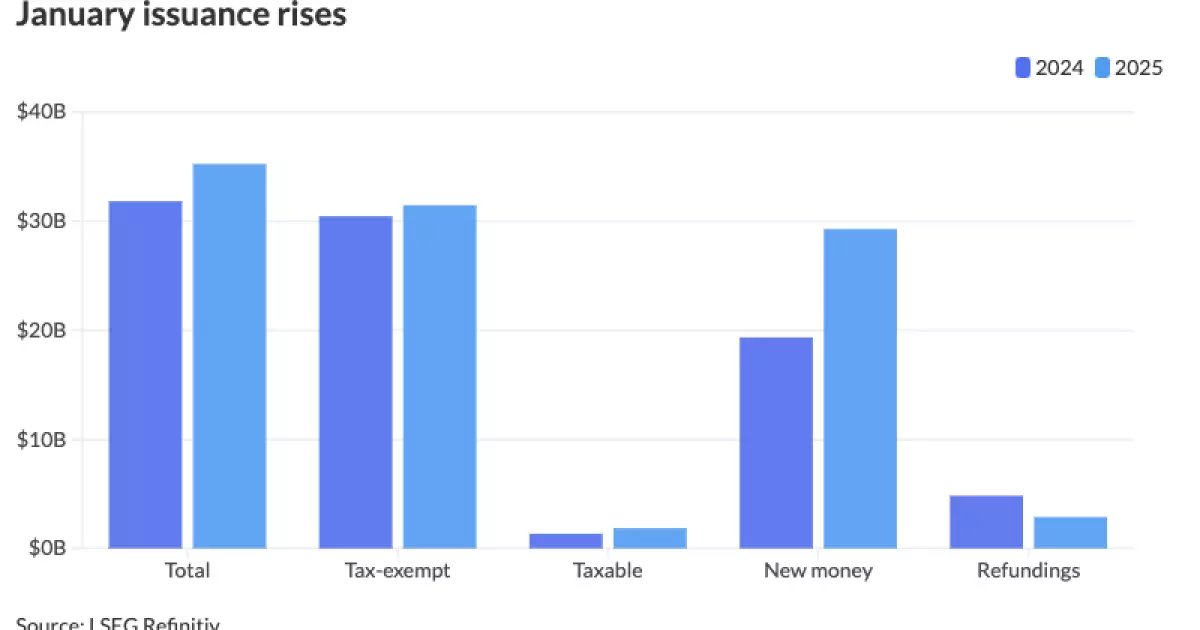The municipal bond market, often seen as a barometer for fiscal health and investment sentiment, experienced a noteworthy surge in issuance during January 2025. This uptick has emerged amidst ongoing uncertainty regarding economic policies and potential tax reforms, raising several questions about the motivations behind such robust activity. By delving into the emerging trends, data analysis, and the contextual implications, we can better comprehend the factors driving this momentum.
Year-on-Year Growth Amid Economic Uncertainty
January’s issuance climbed to an impressive $35.243 billion across 486 issues, marking a significant increase of 10.8% from $31.817 billion with an additional 554 issues in the same month of the previous year. This substantial rise not only outpaces the 10-year average of $28.675 billion for January but also signals a strategic response from issuers seeking to navigate an environment characterized by policy ambiguity and looming fiscal shifts.
Alice Cheng, a credit analyst from Janney, highlights that issuers are taking proactive measures to mitigate potential volatility before anticipated changes from the new administration take effect. The Federal Open Market Committee’s (FOMC) recent decision to maintain interest rates within the range of 4.25% to 4.50% provided some stability, yet President Trump’s advocacy for rate cuts stirred additional uncertainty. Confronted with such a mixed economic backdrop, issuers appear motivated to act swiftly, adopting a “better safe than sorry” attitude relative to future market conditions.
Another critical dimension influencing the surge in bond issuance is the apprehension surrounding the possible withdrawal of funds associated with the Infrastructure Investment and Jobs Act. Cheng articulates that fears of funds being “clawed back” may have urged issuers to capitalize on the market opportunities available now rather than risk delays influenced by shifting governmental agendas.
The ever-evolving landscape of tax regulations has also fueled activity in the municipal bond market. With potential changes posing threats to current tax exemptions—particularly regarding health care and private educational institutions—issuers are likely panicking subtly whilst they can still benefit from existing structures. James Pruskowski, Chief Investment Officer at 16Rock Asset Management, aligns with this sentiment, pointing towards ongoing uncertainty as a likely catalyst for front-loaded issuance.
The brisk pace seen this January can be attributed to numerous factors, including a backlog of projects that had been delayed due to past volatility. Pruskowski notes that many prospective issuers hesitated throughout the latter part of the previous year, resulting in deferred deals that have since piled up. This pent-up demand for capital is coinciding with dwindling funds from COVID-era aid programs, compelling many issuers to seek out financing options to cover ongoing capital requirements.
Cheng asserts that the favorable climate for market entry offered by January encouraged issuers to mobilize and tap into funding avenues, thereby highlighting the underlying need to address delayed project funding across various sectors. As governments transition from reliance on pandemic aid to seeking funding through municipal bonds, it becomes evident that timely action is becoming essential.
Regional Insights and Market Outlook
Breaking down the geographical landscape of municipal issuance in January reveals strong performances across various states. California led the charge with $6.371 billion in issuances, reflecting a 12.6% year-over-year increase, followed closely by Texas and Florida. However, the fluctuations in issuance amounts across states also indicate varying degrees of market confidence and project advancement.
Despite the drop in numbers for Massachusetts, significant gains seen in states like Ohio, which experienced an astonishing 3,631.4% increase in issuance, highlight the dynamic nature of market participation. Such disparities signal that regional economic health and targeted infrastructure projects may materially influence local government funding approaches.
As we evaluate the data and insights surrounding January’s municipal bond market surge, the consensus indicates a robust issuance landscape for 2025. The combination of preemptive strategies adopted by issuers amidst economic uncertainties, alongside a pressing need for capital to fund delayed initiatives, creates a favorable environment for continued growth. Moving forward, it remains crucial for stakeholders to monitor legislative developments and economic indicators that could further shape this evolving landscape.
The early signs from January reaffirm that, while market conditions may fluctuate, the appetite for municipal bonds is indeed on the rise, fueled by both necessity and strategic foresight. With the reservoir of previously shelved projects beginning to tap into the available financing, the momentum seen at the onset of the year is likely to persist, setting a promising tone for the months to come.


Leave a Reply